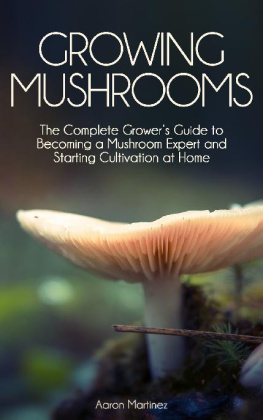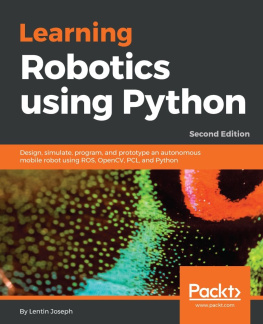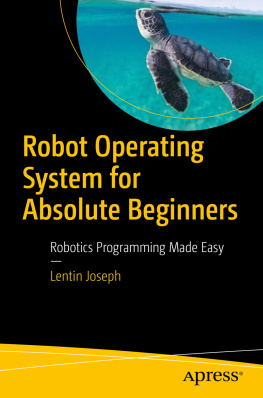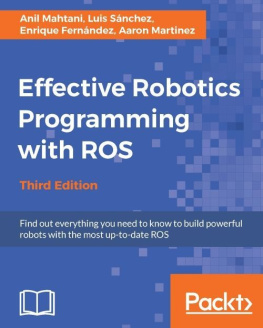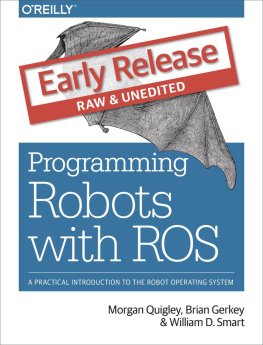Aaron Martinez - Learning ROS for Robotics Programming
Here you can read online Aaron Martinez - Learning ROS for Robotics Programming full text of the book (entire story) in english for free. Download pdf and epub, get meaning, cover and reviews about this ebook. year: 2013, publisher: Packt Publishing, genre: Home and family. Description of the work, (preface) as well as reviews are available. Best literature library LitArk.com created for fans of good reading and offers a wide selection of genres:
Romance novel
Science fiction
Adventure
Detective
Science
History
Home and family
Prose
Art
Politics
Computer
Non-fiction
Religion
Business
Children
Humor
Choose a favorite category and find really read worthwhile books. Enjoy immersion in the world of imagination, feel the emotions of the characters or learn something new for yourself, make an fascinating discovery.
- Book:Learning ROS for Robotics Programming
- Author:
- Publisher:Packt Publishing
- Genre:
- Year:2013
- Rating:5 / 5
- Favourites:Add to favourites
- Your mark:
Learning ROS for Robotics Programming: summary, description and annotation
We offer to read an annotation, description, summary or preface (depends on what the author of the book "Learning ROS for Robotics Programming" wrote himself). If you haven't found the necessary information about the book — write in the comments, we will try to find it.
A practical, instructive, and comprehensive guide to introduce yourself to ROS, the top-notch, leading robotics framework
Overview
- Model your robot on a virtual world and learn how to simulate it
- Carry out state-of-the-art Computer Vision tasks
- Easy to follow, practical tutorials to program your own robots
In Detail
Both the amateur and the professional roboticist who has ever tried their hand at robotics programming will have faced with the cumbersome task of starting from scratch, usually reinventing the wheel. ROS comes with a great number of already working functionalities, and this book takes you from the first steps to the most elaborate designs possible within this software framework.
Learning ROS for Robotics Programming is full of practical examples that will help you to understand the framework from the very beginning. Build your own robot applications in a simulated environment and share your knowledge with the large community supporting ROS.
Learning ROS for Robotics Programming starts with the basic concepts and usage of ROS in a very straightforward and practical manner. It is a painless introduction to the fascinating world of robotics, covering sensor integration, modeling, simulation, computer vision, and navigation algorithms, among other topics.
After the first two chapters, concepts like topics, messages, and nodes will become daily bread. Make your robot see with HD cameras, or navigate avoiding obstacles with range sensors. Furthermore, thanks to the contributions of the vast ROS community, your robot will be able to navigate autonomously, and even recognize and interact with you, in a matter of minutes.
Learning ROS for Robotics Programming will give you all the background you need to know in order to start in the fascinating world of robotics and program your own robot. Simply, you put the limit!
What you will learn from this book
- Install a complete ROS Fuerte system
- Create ROS packages and stacks, using and debugging them in real time
- Create, handle, and debug ROS nodes
- Design your 3D robot model and simulate it in a virtual environment within Gazebo
- Use cameras to give vision to your robots, and calibrate and perform Computer Vision tasks with them
- Use and integrate different sensors like Range Laser, Arduino, and Kinect with your robot
- Create and adapt the navigation stack to work with your robot
- Share your knowledge with the ROS community
Approach
The book will take an easy-to-follow and engaging tutorial approach, providing a practical and comprehensive way to learn ROS.
Who this book is written for
If you are a robotic enthusiast who wants to learn how to build and program your own robots in an easy-to-develop, maintainable and shareable way, Learning ROS for Robotics Programming is for you. In order to make the most of the book, you should have some C++ programming background, knowledge of GNU/Linux systems, and computer science in general. No previous background on ROS is required, since this book provides all the skills required. It is also advisable to have some background on version control systems, like svn or git, which are often used to share the code by the community.
Aaron Martinez: author's other books
Who wrote Learning ROS for Robotics Programming? Find out the surname, the name of the author of the book and a list of all author's works by series.


